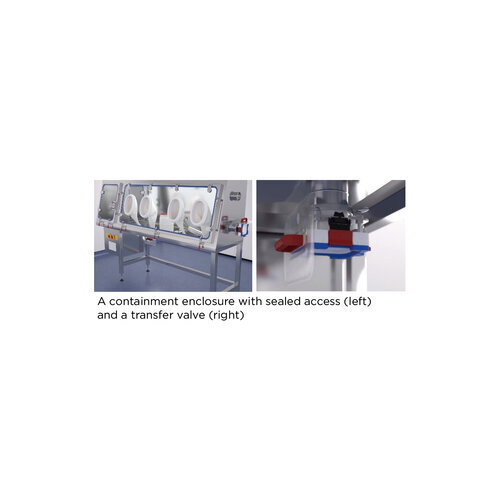How can we ensure containment of APIs and excipients when using low-rate and general feeders?
As feeders become more versatile in their application in the lab and on the production floor, the ability to transfer individual or pre-blended active pharmaceutical ingredients (APIs) and excipients safely from a central containment area to a feeder is critical. Tablet and capsule manufacturers need to achieve 100 percent containment during transfers both at low rates and at production speeds.
Whether for lab trials and low-rate batch blending or for continuous feeding, the goal of containment is to transfer a given amount of material from a storage container to a feeding device without exposing employees or the surrounding environment. Using a simple transfer containment system can help ensure that you don’t lose material and that you can change materials with minimal downtime.
The answers to the following questions can help you choose a transfer method:
What material will you be feeding? The material’s flowability can affect equipment choices, such as the containment valve’s mounting method and the need for flow-aid devices to keep the material moving freely.
How will you receive the material? The receiving process affects the method used to fill containment bags or bottles that attach to the feeder.
How will you integrate the transfer system into the feeder? When setting up a transfer system for a feeder, you must review the feeder inlet options and determine the best way to support the valve and containment bags and bottles.
Parts of a transfer containment system

Containment systems consist of an enclosed housing (photo) with transfer valve (photo) mounted below it. The valve allows an operator to transfer material to a portable containment bag or bottle by mounting the container to the transfer valve and filling it to the weight or volume needed. The photo of the containment enclosure shows a typical design for transferring materials to a bag or bottle.
When choosing the enclosed housing, you must determine the type of engineered system that will best fit your applications. This determination depends on how you will receive the APIs and excipients, how you will contain the dust, and how wash-down or breakdown for cleaning will occur.
For applications that require additional containment for the transfer of APIs and excipients from a storage device to the containment enclosure, additional designs can be considered. Discuss any additional containment requirements with your supplier to create a proper design.
After filling the container, the operator must attach a clamp with a sealing tag for easy transfer.
Transfer to the feeder
After the container is filled and sealed, the operator can transport the material to the feeder. Each feeder will have another transfer valve mounted on the inlet, to which the operator must attach the container for complete containment during transfer into the feed hopper (photos). With a volumetric feeder, typically the transfer valve is mounted to the hopper’s lid. When using a gravimetric feeder with an external automated valve for refilling, the operator must further seal the transfer container to the weigh hopper. For best results, consult your supplier for other mounting capabilities.
The operator can dispose of the empty containment bags or bottles or reuse them if required. Most lab applications require a new containment bag due to the intent to create a different batch or change the material. The bags come prepackaged and ready to use when needed.
Feeder containment
Feeders typically require adaptions of different types to use a transfer containment system, including:
Lid modifications or new design. The containment valves that mount on feeders typically have 4- or 6-inch sanitary clamp outlets. Due to the many feeder lid designs on the market, typically you must design an adapter to accommodate the current lid or design a new lid that allows easy removal for cleaning.
An external mounting frame to support the transfer-valve configuration and the volume of material that you plan to transfer. If you will be using different volumes of material in either a bag or bottle, you need to consider the weight of the container. Additional support may be necessary for the feeder and/or the containment-valve connection. Dust containment, if required. Certain applications may require some type of enclosure around a feeder to protect operators from exposure to the materials being fed. If you need dust containment, the system may require an external bag mounting; your supplier can help you make this determination.
Additional modifications for gravimetric systems depending on your current setup and the rates at which you will be running the system. Processes using a gravimetric feeder will require an external mount to prevent interference with the weigh-scale readings and ensure feeding accuracy.
